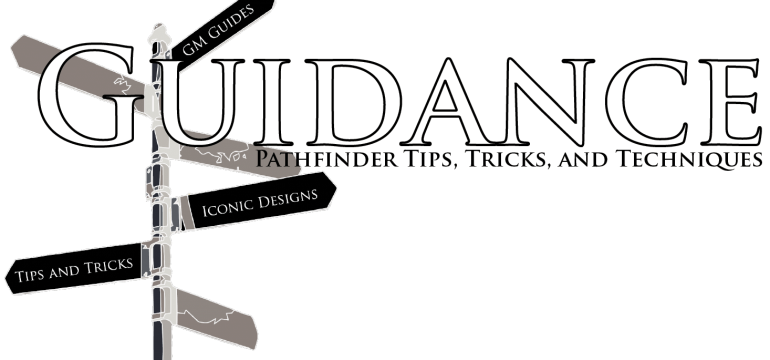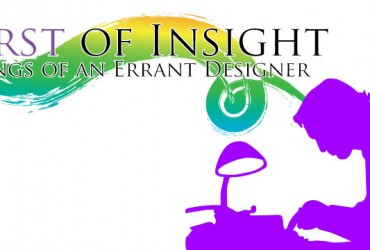As you might know, I started GMing my first Adventure Path a few months ago. Currently, I’m running Strange Aeons, which has been very new and exciting for me. Prior to this, I’ve only played in the first three books in Carrion Crown (our GM needed a break after we had been working on it for almost two years) and books one through four in Reign of Winter (we’re still actively working on that AP). Now, both of my GMs for those two Adventure Paths had altered content, but going into Strange Aeons I wasn’t sure just HOW much I wanted to change around. You see, Strange Aeons is in this really weird place where it gives the GM a couple of years of “forgotten time” to put onto their players. (Example—I told the players that they could write their backstories up to a few years ago, after which the Adventure Path and I got to determine what happened to their characters. This was a condition of playing in the AP, and my group was cool with it.)
Complicating my desire to change up the AP was the fact that I accidentally invited six people to play instead of the standard four that the AP suggests. Granted, I was going to stick with five people, but after I accidentally gave someone the impression they could play with us, I didn’t want to be that guy and turn them down. But, I mean, let’s face it—it is SUPER difficult to challenge a six-person party using an Adventure Path that was written for four people. This made me wanted to change things EVEN MORE. So I experimented, and today I come bearing the fruit of my labors! For you, my dear readers.
Case #1 — No Party Like Ghoul Party
So in the first book of Strange Aeons, the party is expected to fight a bunch of ghouls. Now, I was REALLY worried that the PCs were going to blitz through that part of the adventure because, seriously? Three CR 2 ghouls versus a militia of level 3 players? They’d DEMOLISH those little ghouls! So I used my own advice, pulled out the GM’s Guide to Challenging Encounters, and toughed up the encounters. I put in two really high CR ghouls (two CR 7s) who used at-level gear and had suboptimal tactics for story reasons. (One of the ghouls is missing his left hand, as per the AP!) The party triumphed as I had hoped, but it was harrowing. I used the higher CR fighters as a means to infuse some additional wealth into the adventure as well. It was a win-win! However, there was ONE teeny problem….
“Who were those ghouls?” I froze when one of my players asked me this. I quickly came up with a good justification on the spot—they were former high-ranking security members of the Briarstone Aslyum. My players bought it. But … I didn’t. Challenging encounters are bested served as pivotal encounters for important scenes, and I went out of my way to modify those two encounters. In fact, the fighters, which would have likely taken ten to thirty minutes tops, lasted almost 90 minutes each. And while it was super fun to make them sweat, I kept coming back to that single question.
“Why?”
I didn’t understand why I felt that way until they had completed the third encounter that I had modified.
The Oneirogen
**WARNING — This next part has mild spoilers for the Strange Aeons Adventure Path**
The next encounter that I modified was with an oneirogen. I can’t really tell you what they are without spoiling some of the coolness of the Strange Aeons adventure path, but know that they’re outsiders with a cool connection to dreams and that they’re introduced in Strange Aeons Part 1.
So ‘In Search of Sanity’ HEAVILY foreshadows the oneirogens before they appear through roleplaying and discovery of these creatures, and unfortunately, I had REALLY built up them up to the PCs. Like, to the point that I realized that it was a problem when they started prebuffing right before they entered the chamber where they knew it was. They were expecting this BIG fight, but honestly, as written I knew that the oneirogen wouldn’t be a challenge at all. I had two choices—call the night early, or wing it. And being the Everyman Gamer, there was only one real option.
Wing it, baby.
I decided right away that I didn’t want this to be a lethal fight—I wanted the PCs to feel the epic scope of things and for the fight to feel spectacular and grand, but I didn’t want them to die to my hand-waving. So I did the cheapest trick in the book. I gave the monster the following spell at will as a supernatural ability: quickened mass unwilling shield. Why yes, I DID totally make that spell up, thank you!
I don’t know if you’ve ever seen unwilling shield, but it is AWESOME when you can spam it a lot. It’s basically shield other, but the target takes YOUR damage if they fail a Will save. So basically, I had the group walk into the room and had them each make a save on their turn. (I calculated the DC out to be 18; hard, but not impossible). If a PC failed, an unwilling shield was established between them and the oneirogan. If they passed, they were immune to the ability for 24 hours. As expected, most of my PCs failed. But rather than say, “Oh, now you have this mystic mumbo-jumbo,” on a second spontaneous whim, I decided to connect the failed save to the PCs. You see, the oneirogen in the AP are connected to dreams, and the PCs have lost a lot of their memories, so I decided to “give” some of those memories back by having scenes from the character’s backstories appear when they failed this save. For the elf who watched her mother get assassinated, the assassin appeared, taunting her. For the bard who thought he accidentally killed his parents, their dead, poisoned bodies appeared. So on and so forth.
Now as luck would have it, by the end of the first round, I had five unwilling shield effects up. As written, I’m PRETTY sure that in this case, I’m supposed to divide the damage up equally between all players. But that was boring and took too much math, so more spontaneous meddling–each time someone damaged the oneirogan, I rolled a random die and the player who I rolled got the damage. Barbarian attacking the monster and I roll ‘wizard’? Soooooorrry! It was REALLY fun and REALLY tense, but the best part? The players were all trying to roleplay in the middle of combat with these REALLY intense scenes from their backstories! It was awesome, and when I got home, I realized why the ghoul fights felt so underwhelming.
Challenge as Tension
You ever notice how in movies, the most tense moments often involve a source of extreme challenge AND conflict? For example, in Rogue One, the scene isn’t tense when the heroes are doing well, even though there’s danger around. The reason is that its not IMPORTANT danger. It’s not “danger with a face,” so to speak.
That’s why things are SO much more tense at the final fight scene—main character on the roof, staring down the antagonist as rebels fight and die around her. You KNOW this villain is important. He has a name and a face, and moreover, his place in the story MAKES him a threat. So too is it with challenges. If every encounter is equally challenging, then the players have a harder time distinguishing when the important moments are. Those pivotal scenes in the adventure’s story that you WANT the PCs to know and remember. The “Boss Fights” as they were. If an adventure does it’s job well and foreshadows powerful enemies, THOSE are the times you want to step in and tweak up the difficulty. Make things fun, doable, but HARD. Make the PCs sweat. To put it another way, easy encounters are just as important as hard encounters—the easy encounters are VITAL to making the PCs feel like heroes, while the hard encounters make the PCs realize when things are important.
In my most recent game of Strange Aeons, the group is now dealing with a militia of juju zombbies. The zombies themselves aren’t hard, but it’s a LONG way between the MANY rooms of zombies and the important NPCs, so after two encounters with “smaller” groups of zombies, I decided to allow the militia to use its “call for reinforcements” tactics to call for help a little bit earlier than written. I had already foreshadowed that there were probably a LOT of zombies in the building, and I didn’t want my group to have to fight room after room of 1-2 zombie soldiers. It was a LOT cooler for them to be fighting a total of eight of them in waves, and it gave them time to shine using their tactics. (There was a great use of hold portal by our wizard, who effectively turned the room they were occupying into a one-way zombie grinder.) It was fun, interesting, sped up the part of the book a little bit, and also took the easy threat and boosted it up a little bit. They had fun, I had fun, and at the end of the day, that’s the reason you modify encounters—do it to create the most fun, evocative scenes you can at your tables. Not to simply give your PCs a rough time of it.
So until next time, I’m Alex Augunas and I’m always here for YOU when you need a little bit of Guidance. Take care!
Alexander “Alex” Augunas has been playing roleplaying games since 2007, which isn’t nearly as long as 90% of his colleagues. Alexander is an active freelancer for the Pathfinder Roleplaying Game and is best known as the author of the Pact Magic Unbound series by Radiance House. Alex is the owner of Everyman Gaming, LLC and is often stylized as the Everyman Gamer in honor of Guidance’s original home. Alex also cohosts the Private Sanctuary Podcast, along with fellow blogger Anthony Li, and you can follow their exploits on Facebook in the 3.5 Private Sanctuary Group, or on Alex’s Twitter, @AlJAug.






